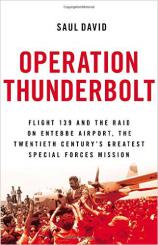Operation Thunderbolt: Flight 139 and the Raid on Entebbe Airport, the Most Audacious Hostage Rescue Mission in History
Review
Operation Thunderbolt: Flight 139 and the Raid on Entebbe Airport, the Most Audacious Hostage Rescue Mission in History
Shimon Peres and Yitzhak Rabin are names many know today only for their leadership in the State of Israel. Each man served terms as Prime Minister, as well as in the Israeli military and various political positions. But in 1976, they faced a terrifying emergency: the hijacking of Air France Flight 139 by Arab and German terrorists, who demanded the release of imprisoned terrorists in exchange for the safe return of the plane’s passengers and crew.
Air travel in 1976 was dramatically different from what it is today. Security, while present, varied in effectiveness from country to country. In Greece it was notoriously slack, while in Israel it was the strictest in the entire world. During this era, hijackings were much more common, reaching a height of 82 in the single year of 1969. These hijackings were often focused on the takeovers of Israeli airplanes by pro-Palestinian terror groups, following Israel’s defeat of Jordan, Syria and Egypt in the Six-Day War. In response, Israel tightened its airport security and became the safest country in the world to fly from, with thorough examinations of every single passenger (and accompanying baggage) boarding flights departing Israel.
On June 27, 1976, over 200 passengers boarded Air France Flight 139 at Israel’s Ben Gurion International Airport. Many were alarmed to learn upon check-in that the plane would be making an unplanned stop in Athens, Greece; one child on the flight, Olivier Cojot, remarked to his father, “Hey Dad, if I were a terrorist I would get on at the stopover.” Ellinikon International Airport was known, apparently even to children, as the easiest place for a terrorist to board a plane, along with weapons. Several of the passengers attempted to change to El Al flights in response to this, yet were unable to secure seats elsewhere.
"Saul David has crafted a meticulously researched account of Operation Thunderbolt.... [R]eaders will feel that they are on the sidelines watching one of the most momentous rescues in the history of the State of Israel."
Flight 139 took off on a beautiful sunny morning and headed without incident to Athens, where 38 passengers left the plane and 56 boarded it. Unknown to the plane’s crew and Ellinikon’s security, among the travelers were four PLFP (Popular Front for the Liberation of Palestine) hijackers. (It must be noted that the metal detector for all actually entering the terminal from Athens was quite effective on that day, yet scrutiny of those transferring from one plane to another was barely monitored, as they were assumed to have been examined already.)
The four, along with their large bags of arms, were transferring from a Bahrain flight. Two Germans and two Arabs, members of the PLFP (which was known as a particularly dangerous segment of the Palestine Liberation Organization, as well as the originator of hijackings of Israeli planes), took control of Flight 139 only eight minutes after takeoff. They further secured control by separating the mothers and children from the men, placing them in first class while the rest were left in the economy section. And now, the plane changed course from a Paris route to Benghazi, Libya, a safe place for Palestinian terrorists. Eventually, Flight 139 would head to Entebbe, Uganda, where President Idi Amin actually colluded with the hijackers by providing food, an old airport terminal to house the passengers, and additional Ugandan soldiers for guard duty.
Back in Israel, Prime Minister Yitzhak Rabin held his regular mid-week meeting with his Cabinet members, when he was handed a note informing him of the Air France hijacking. Having recently experienced the disaster with Palestinian terrorists’ hostage-taking of the Ma’alot elementary school (in which Israeli soldiers attempted to take over the school, yet the terrorists killed dozens of schoolchildren), Rabin was hesitant to plan a military rescue. His feeling was that no Jew should die when a peaceful option was possible. Yet his Minister of Defense, Shimon Peres, believed that Israel must not give in to blackmail; if they met the terrorists’ demands, then any terrorist anywhere would believe that Israel would give in.
Nevertheless, the greatest Israeli rescue mission --- which would become known as Operation Thunderbolt --- would soon be planned. When the demands became known (the release of 53 imprisoned fellow terrorists), members of Israeli Special Forces (including Benjamin Netanyahu’s older brother, Yoni) developed a plan of attack. Would the hostages be rescued in time before the deadline set by the terrorists?
Saul David has crafted a meticulously researched account of Operation Thunderbolt. With interviews included from members of the Special Forces team, passengers and the terrorists themselves, readers will feel that they are on the sidelines watching one of the most momentous rescues in the history of the State of Israel. Don’t miss this compelling account that reads like a political thriller yet tells a true story.
Reviewed by Melanie Reynolds on December 18, 2015
Operation Thunderbolt: Flight 139 and the Raid on Entebbe Airport, the Most Audacious Hostage Rescue Mission in History
- Publication Date: March 14, 2017
- Genres: History, Nonfiction
- Paperback: 464 pages
- Publisher: Back Bay Books
- ISBN-10: 0316245399
- ISBN-13: 9780316245395





